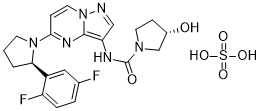| Cas No.: | 1223405-08-0 |
| Chemical Name: | Larotrectinib sulfate |
| Synonyms: | LOXO-101 (sulfate);Larotrectinib sulfate;LOXO101 sulfate;P4465消泡剂 水性涂料 油墨消泡剂;(3R)-N-[5-[(2R)-2-(2,5-Difluorophenyl)pyrrolidin-1-yl]pyrazolo[1,5-a]pyrimidin-3-yl]-3-hydroxypyrrol |
| SMILES: | O=C(N1C[C@@H](O)CC1)NC2=C3N=C(N4[C@@H](C5=CC(F)=CC=C5F)CCC4)C=CN3N=C2.O=S(O)(O)=O |
| Formula: | C21H24F2N6O6S |
| M.Wt: | 526.51 |
| Purity: | >98% |
| Sotrage: | 4°C for 1 year, -20°C for more than 2 years |
| Description: | Larotrectinib (LOXO-101) sulfate is an ATP-competitive oral, selective inhibitor of the tropomyosin-related kinase (TRK) family receptors, with low nanomolar 50% inhibitory concentrations against all three isoforms (TRKA, B, and C). |
| In Vivo: | In rat and monkey studies, Larotrectinib (LOXO-101) demonstrates 33-100% oral bioavailability and 60-65% plasma protein binding. It has low brain penetration, and is well tolerated in 28 day (d) GLP toxicology studies. A single dose (30 mg/kg) of Larotrectinib (LOXO-101) reduces tyrosine phosphorylation of TRKA and downstream signal transduction (pERK) in the tumor >80%[1]. Athymic nude mice injected with KM12 cells are treated with Larotrectinib sulfate orally daily for 2 weeks. Dose-dependent tumor inhibition is observed demonstrating the ability of this selective compound to inhibit tumor growth in vivo[4]. Larotrectinib (LOXO-101) (200mg/kg/day p.o for six weeks) reduces leukemic infiltration to undetectable levels in the bone marrow and spleen compared to vehicle-treated mice. Mice treated with Larotrectinib sulfate are still alive and leukemia-free four weeks after the cessation of treatment, as determined by Xenogen imaging[5]. |
| In Vitro: | Larotrectinib (LOXO-101) is an ATP-competitive oral inhibitor of the tropomyosin-related kinase (TRK) family of receptor kinases (TRKA, B, and C), with low nanomolar 50% inhibitory concentrations against all three isoforms, and 1,000-fold or greater selectivity relative to other kinases[1][2]. Measurement of proliferation following treatment with Larotrectinib (LOXO-101) demonstrates a dose-dependent inhibition of cell proliferation in all three cell lines. The IC50 is less than 100 nM for CUTO-3.29 and less than 10 nM for KM12 and MO-91 consistent with the known potency of this drug for the TRK kinase family[3]. |

 DC Chemicals' products qualify for U.S. tariff exemptions. We guarantee no price increases due to customs duties and maintain stable supply, continuing to deliver reliable research solutions to our American clients.
DC Chemicals' products qualify for U.S. tariff exemptions. We guarantee no price increases due to customs duties and maintain stable supply, continuing to deliver reliable research solutions to our American clients.





















